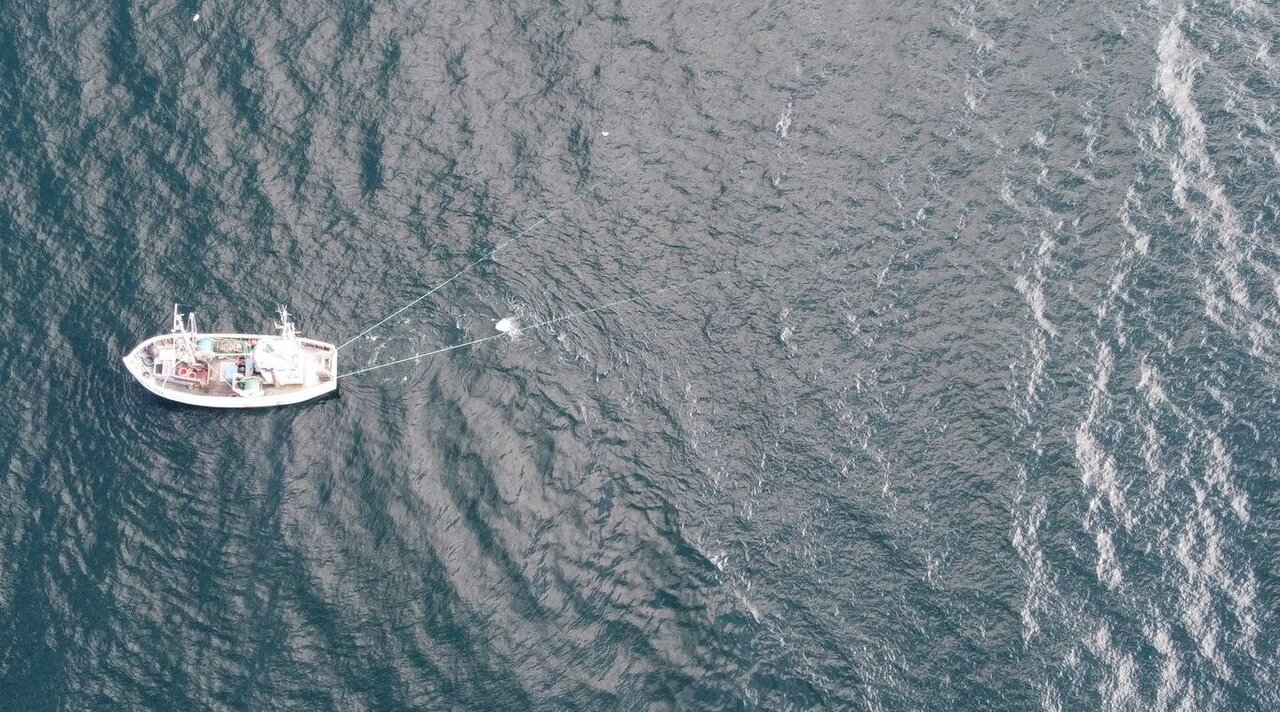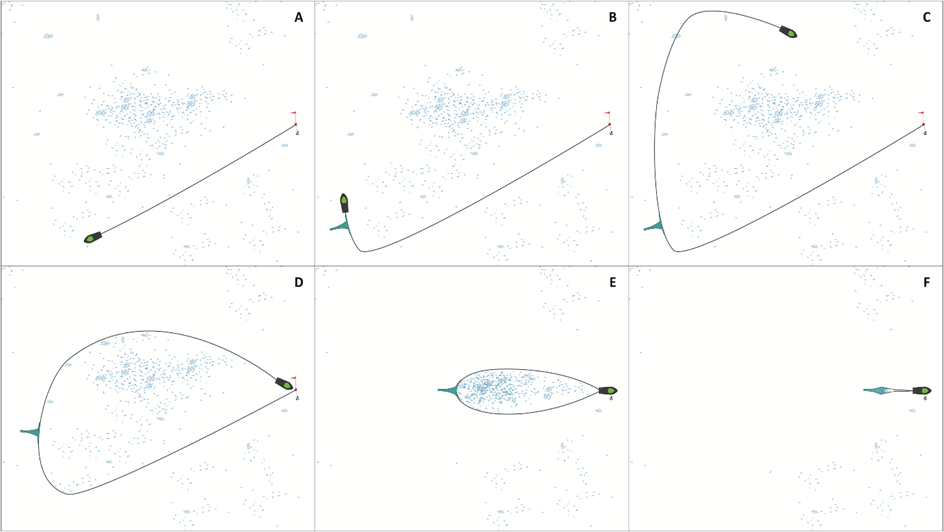Project
MiniSeine - a small Danish seine for German coastal fisheries

Background and Objective
We are trying to reduce the environmental impact of fishing gear - including the impact of towed gear on the seabed. The Snurrewade (Danish Seine) is ideal for this, as it also saves fuel and makes the catch inaccessible to grey seals. However, this device needs to be miniaturised for use on small coastal fishing vessels - such a MiniSeine we are developing and testing in this project together with fisheries.
The socially desired return of grey seals to the German Baltic Sea coast is a conservation success story. However, grey seals eat fish caught in gillnets and/or damage these nets. Even the currently still low grey seal population in this country means that in some regions gillnet fishing is no longer profitable.
However, this is by far the most important fishing method of the Baltic Sea coastal fishery. In order to be prepared for this development, ways should be worked out in good time to ensure that German coastal fishing can continue to be ecologically and economically sustainable in the future.
Fishing technology solutions can play an important role in counteracting the conflict between nature conservation and nature use. Current fishing gear can be modified or alternative "seal-proof" fishing gear can be developed, tested and used. One strategy here is to protect the catch from seals by preventing the seals from reaching the fish caught (e.g. in fish traps). Another option is to not give the seals enough time to reach the caught fish. A promising alternative fishing gear is the MiniSeine (small Danish seine).
Until the 1950s, it was also a common fishing gear in German Baltic Sea fisheries. However, with advancing industrialisation and the introduction of trawling, interest in this fishing method rapidly declined.
The MiniSeine is derived from the traditional Danish snurrewade (Danish: snurrevod), which was developed in Denmark in 1848.
When fishing with the snurrewade, an anchor is first set at the fishing spot, to which at least one marker buoy and one end of the first seine line are attached. This seine line is then laid out in a bow shape (Fig. 1A). After setting the seine (small net), which is attached to the other end of the first seine line (Fig. 1B), the second seine line is also laid out in an arc (Fig. 1C). Once the seine itself and the second line are laid out, the vessel returns to the anchor (Fig. 1D), picks up the beginning of the first line and starts hauling in both lines. The hoisting itself is done relatively slowly via winches. While the size of the area enclosed by the lines thus gradually decreases, the fish are driven in front of the approaching seine (Fig. 1E).
The Danish seine has great potential for solving current problems in coastal fisheries. It removes the caught fish from the grasp of grey seals, while at the same time the probability of bycatch of seabirds and mammals is very low. The impact of this fishery on the seabed is much lower than in the bottom trawl fishery, and compared to this, the Danish seine fishery has a much lower fuel consumption. Finally, the quality of the catch is much higher compared to the gillnet and trawl.
Studies on selectivity and seabed impact are currently underway in the Danish flatfish fishery. The next goal is miniaturisation: as commercial Danish trawlers far exceed the size of a conventional gillnet vessel due to the dimensions of the equipment required on board (net drum, line drums, etc.), it was necessary to develop a system that could be used by these smaller vessels. Thus the idea of the "MiniSeine" was born. Trials have been conducted in Denmark since 2018. However, the topographical conditions (especially a flat sandy bottom without stones) are even better in German waters. Together with the fishing industry, we are now developing this method further.
Target Group
Nature conservation, fisheries
Approach
Since good knowledge of the local conditions is essential when testing a new fishing gear, the tests are carried out in cooperation with the fishery. The scientific community provides the prototype of the MiniSeine system, including lines and seine, which was tested in Denmark beforehand, and accompanies the first trials. Trial planning and implementation are taking place in close coordination with DTU Aqua, which coordinated the trials that took place previously. As soon as the fishing works satisfactorily, a continuation of the trials without scientific personnel on board is conceivable. In this case, the fisherman himself would be responsible for data collection (self-sampling). The data collected by the fisherman is passed on daily to the scientific team, where it is quickly evaluated in order to be able to react quickly to potential problems - for example through technical adjustments or further trips.
Data and Methods
In addition to logging all catches, sensors are used to record the position of the vessel and the fishing activities. Underwater video technology is also used to observe the behaviour of the fish and the performance of the fishing gear during the fishing process.
Our Research Questions
- Can the MiniSeine system be used from a vessel typical of German Baltic coastal fisheries?
- Are there suitable areas off the German Baltic Sea coast for practising this fishery?
- Which species can be fished off the German Baltic coast and in what quantities with the system?
Results
During the project, it was demonstrated that the MiniSeine can be efficiently deployed in German coastal waters. Following the successful assembly of the system on a small vessel (<10 m), a total of 21 hauls were conducted with the small Snurrevod during the trial period in the summer of 2022. These were distributed across three different fishing areas in the Kiel Bight, the Lübeck Bight, and the Mecklenburg Bight. Although no direct comparison of catches with gillnets was possible, the detailed recorded catches were compared with statements from gillnet fishermen in the area, revealing that both the composition and quantities of the catch were similar in relation to the necessary labor involved. The catch per haul was up to 150 kg, with the majority in all three fishing areas consisting of plaice (Pleuronectes platessa). In addition to the detailed documentation of catches, individual hauls were also recorded using GPS loggers and cameras (on deck and on the fishing gear). With the help of these recordings, initial problems (deployment patterns, vehicle maneuvering, fishing location choice depending on bottom structure) were solved, thereby ensuring largely trouble-free fishing after a certain period of acclimatization and on suitable grounds.
The project once again highlighted the potential of the MiniSeine as a potential seal-safe alternative to gillnets. However, the use of the MiniSeine requires a fully functional MiniSeine system and sufficiently fishable areas.
Thünen-Contact

Involved Thünen-Partners
Duration
1.2022 - 12.2023
More Information
Project status:
finished

![[Translate to English:] [Translate to English:]](/media/_processed_/d/7/csm_Startseite-OF_03_c0dfd6e750.png)
![[Translate to English:] [Translate to English:]](/media/_processed_/a/3/csm_20181116-151457-Stella-Jerome-Fischfalle-Warnem%C3%BCnde-Dorsche-im-Netzk%C3%A4fig-5691_heller_3050c72fa2.png)






